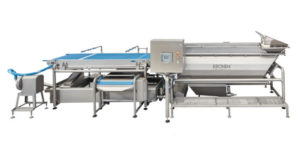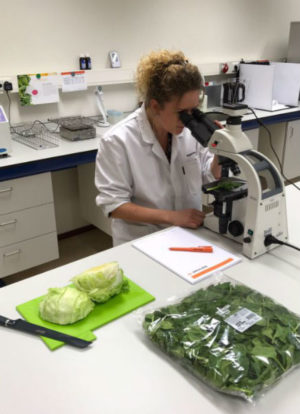Equipment manufacturers go the extra mile to enhance food safety
Eliminating bacteria while reducing the risk of cross contamination can be a challenge when processing fresh-cut produce. For the longest time, processors relied on wash sanitizers to reduce microbial counts, while trying to extend shelf life and maintain quality. Ensuring end product meets food safety standards has traditionally been the responsibility of processors, not equipment manufacturers. More and more, though, equipment manufacturers are seeing the value of offering their customers a more complete solution. Two companies, Kronen and Sormac, shared their sanitizing solutions at this year’s Fruit Logistica, held every February in Berlin, Germany.
Processing of packaged convenience salads includes everything from cleaning and cutting to washing, drying and packaging. Products are generally washed in a two-stage process. In the first stage, coarse pollutants are removed; the second stage is the post-wash. Challenges surface at both stages.

Kronen
“Even intensive washing results only in a reduction of microorganisms by 1–2 log,” explained Eric Lefebvre, technical manager, Kronen. “Recycling of wash water to reduce water consumption also carries the risk of cross-contamination.”
Currently, Kronen is working with universities and laboratories across Europe in projects that look at how to reduce the risk of cross contamination. In one project in Germany, the aim is to develop an innovative method to disinfect process water for fresh-cut ready-to-eat salad in order to increase microbiological safety in the process and to significantly reduce fresh water consumption.
“At redox potentials above 650–700 mV bacteria are killed within seconds,” said Lefebvre. “This fact should be used to achieve maximum reduction of microbial spoilage organisms, as well as human pathogens, and to improve the shelf life of products.”
“It is planned to develop a flow-through single-chamber electrolysis cell that requires no additives that can be integrated into existing salad washing machines,” he continued. “The developed cell should have an integrated control unit in order to sanitize the washing water in time according to individual demand.”
In another project with Citrosol in Spain, Kronen is looking at using peracetic acid, a disinfectant and cleanser that is used to remove bacteria and fungus from fruits and vegetables, and for the disinfection of recycled wash water.
The project is looking at how peracetic acid can be used to reduce cross contamination and decontaminate water.
In both projects, Kronen’s part of the solution is to design washers that are adapted to the solutions. Peracetic acid, he said, is best used on very dirty products that leave a lot of residue in the water. Electrolysis offers a good solution for products that are less dirty. The idea, ultimately, is to offer customers a more holistic, food safety-focused solution.
“We don’t just have to sell stainless steel, but sell a complete solution with detailed parameters for our customers,” said Lefebvre. “We have to think differently. We have to think bacteria.”
To learn more about the project between Kronen and Citrosol, visit: http://aquafreshproject.eu/.
Sormac
Kronen isn’t the only equipment manufacturer that wants to provide its clients with a more holistic solution. A year and a half ago, Dutch company Sormac built a food laboratory on their manufacturing site. The company’s goal was to add value for their end users to the products processed by their equipment. Marianne Knorr-Jansen works in that food laboratory as a food technologist.

“With this laboratory we are trying to give some added value to our customers,” she said. “We help the customers with their issues so that they can always deliver the best product to their end users.”
Knorr-Jansen says the information they gather in the laboratory is also used to improve machinery and production lines.
For example, Knorr-Jansen compared spinach leaves after they had been dried in one of two systems – a drying tunnel and a vertical spin dryer – to see if there were differences in shelf life and microbiology and see if there was a relationship between the two.
“We saw differences in the growing microorganisms,” said Knorr-Jansen. “Also, we saw that in lots of cases during the research that the product coming out of the air drying tunnel has a longer shelf life.”
Now, said Knorr-Jansen, they’re trying to find the why behind the research. “There are lots of parameters that influence shelf life,” she said. “But we are still researching the why.”
In the lab, Knorr-Jansen is also looking at pathogens and trying to learn more about the relationship between them and non-pathogenic bacteria. While final data isn’t ready to be presented yet, Knorr-Jansen says that they do see a reduction in total bacterial counts when certain equipment is used.
Knorr-Jansen says they have really only begun their research. E. coli has been evaluated in the lab, she said, but a literature study must be conducted first before they can further examine their equipment’s impact on listeria.
“The laboratory is very unique to Sormac,” said Knorr-Jansen. “This development enables us to have interesting conversations with our customer about the end product in relation to our machinery and production lines.”
“It’s important to know that we are working to help our customers,” she concluded. “Customers can always ask us if they have microbiology or physiological issues with their products so we can help them. That’s an added value to our customers. Most important, though, we are trying to investigate products and trying to make our machines better.” For more on Sormac’s food laboratory work, visit: http://bit.ly/2zimA0c.










